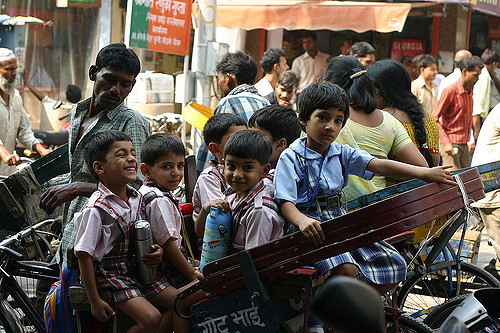- About
- Topics
- Picks
- Audio
- Story
- In-Depth
- Opinion
- News
- Donate
- Signup for our newsletterOur Editors' Best Picks.Send
Read, Debate: Engage.
| July 17, 2021 | |
|---|---|
| topic: | Child rights |
| tags: | #mica, #mining, #India, #child labour, #beauty products |
| located: | India |
| by: | Katarzyna Rybarczyk |
For years, India has been recognised as the largest producer and exporter of sheet mica globally, with most mines located in Bihar and Jharkhand states. The two regions are among India’s most impoverished. The poverty incidence in Jharkhand is estimated at over forty-six percent. In Bihar, it ranges from forty-six to seventy percent, depending on the district. And as many families live on the edge of starvation, it is not uncommon for children to drop out of school and engage in child labour.
Despite the fact that mica mining poses serious threats to children’s health and safety, families rely on it for income, and communities living in proximity to mica mines are trapped in an endless cycle of poverty, exploitation and abuse, where every day is a struggle to survive.
It is estimated that 22,000 children as young as four work in mica mines in Jharkhand and Bihar, and due to the illegal and secretive nature of child labour, the exact numbers are unknown.
Going into narrow tunnels and caves is necessary in order to extract mica; children can fit into them more easily than adults, which constitutes the main reason for the widespread use of kids in mica mining. Of course, desperately trying to take advantage of any possibility to earn money is another key driver of the problem. Without the children’s contribution to the family wage, many would not meet their basic needs.
Refinery29, a media company that focuses on women’s issues, visited one of the illegal Indian mica mines and spoke to children who work there. “If we don’t pick mica, how will we put food on the table?” an eleven-year-old girl who works at the mine every day said.
Most children who work in mica mines earn fifty rupees a day, equivalent to around seventy cents. On the other hand, wholesalers can earn more than a thousand US dollars for a kilogram of good quality mica. That illustrates the scale of exploitation and horrendous human rights violations taking place in mica mines.
Illegal mica mining is associated with numerous dangers to children’s health and safety. Constant exposure to dust can trigger respiratory illnesses, and spending hours digging in soil with their bare hands puts them at risk of skin infections and cuts. Moreover, the mines frequently collapse, threatening children’s lives.
Refinery29’s host also spoke to the parents of a girl who lost her life when the tunnel collapsed while she was mining mica. “I rushed over to the mine and saw my daughter lying there. There was a big rock on top of her, and she was already dead” - recalled the devastated mother. Yet, she added that as they have no other options, the rest of the family, including their second daughter, continued to work in the mine after the heartbreaking event.
When the mining shafts cave in, children get trapped under the rocks, and with the mines being unsupervised, there is no way to get adequate help in time. Families live in constant fear of losing their children, and since mining mica is unregulated, they are not eligible for any compensation when accidents happen. Working in illegal mines also makes children vulnerable to sexual and physical abuse or human trafficking.
People living in mines’ vicinity are aware of the risks, but with no other livelihood options, working illegally is better than not working at all. Still, growing up mining mica instead of getting an education deprives children of a happy childhood and limits their future employment opportunities.
Reuters reported that Jharkhand’s government has been wanting to legalise the sector, but the process has been plodding. If more regulations were put in place, mica mining would create more job opportunities for villagers, giving them better pay and decreasing the need for children’s involvement. In turn, children would get a chance for a future that does not involve mining mica.
To help end the cycle of abuse in mica mining, some beauty companies have been exploring the use of synthetic mica. At first glance, it seems like a sustainable solution: since synthetic mica is made in a lab, there is no child labour required. In reality, however, its supply chain is not always transparent, and there is no guarantee that the alternative type of mica is entirely child labour-free.
Furthermore, one might think that as end-users purchasing mica cosmetics we become accountable for contributing to child labour. While there certainly is some truth to it, in India, the lives of whole communities revolve around extracting mica. Hence, completely abandoning these products would mean depriving families of their only income-generating activity.
As exploitative as mining the mineral is, it allows thousands of families to survive. Without mica, the poverty and suffering in Bihar and Jharkhand would reach unimaginable levels. The moral dilemma is apparent, and finding a solution to the problem is immensely difficult.
What is clear, however, is that no child should be forced into hazardous labour and exploitation. Empowering children and their parents and providing them with professional training is essential to reduce their dependence on illegal mica mining. So is improving living conditions in the areas surrounding the mines and raising awareness about the importance of education.
Instead of merely boycotting products containing mica, we should escalate efforts to establish a clean supply chain, regulate mica mining and help rural Indian communities find safe employment elsewhere.
Image: Yash mevawala.
By copying the embed code below, you agree to adhere to our republishing guidelines.
